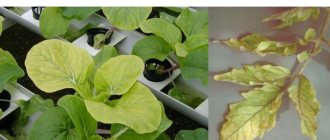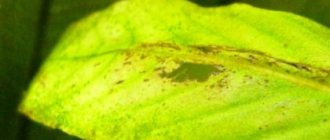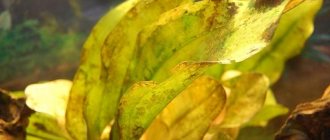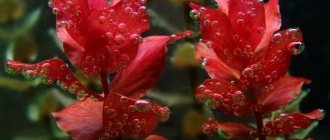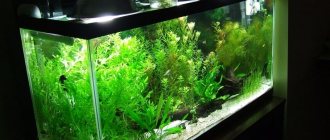Home › Aquarium plants ›
( 8 ratings, average: 4.00 out of 5)
Live plants in an aquarium are always beautiful and natural, but contrasts make natural aquariums especially attractive and interesting. And plants with red leaves help to make plants with red leaves (red red in English) especially bright contrast and color spots. Aquarium plants can be found in a variety of red shades, from pinkish to purple. Some have completely red leaves, while others only have a reddish tint.
Often, the appearance of red color in the leaves depends on the conditions: lighting brightness, nutrients (nitrates and iron especially affect the color of the leaves), CO2. But there are species in which the leaves remain bright red regardless of environmental conditions. Most red plants, however, prefer strong bright light, nutrients in the soil and water, and a sufficient amount of carbon dioxide.
And yet, you can always choose a more suitable type for yourself, even if you are a beginner, you just need to first familiarize yourself with the content requirements.
Below I present the top 10 most famous and popular and most brightly colored aquarium plants.
Ludwigia
Top 1 Ludwigia is perhaps the most common, well-known and popular red aquarium plant. Most ludwigias are quite unpretentious and prefer cool water, so there is no need for a heater in the aquarium, and special conditions are not required to obtain the red color of the leaves.
There are several types of Ludwigia with red leaves: creeping, swamp, super red, ruby, Peruvian, glandulosa, arcuata and many others. Depending on the species, the leaves can be either slightly red or deep red, burgundy with a purple tint. Most species are found in nature in the middle zone, therefore they are resistant to low temperatures.
Ludwigia swamp
All Ludwigias are plants with a powerful root system and long stems. Requires planting in a soil layer of 5 cm, prefers root nutrition. The brightness of the light depends on the species, but some can grow even in moderate light. But the better the light, the brighter and more beautiful the leaves, the faster Ludwigia grows.
Ludwigia super ed
In the aquarium, ludwigs are used to decorate the middle and background. These plants can be used to create stunning red-green color combinations in aquariums.
Ludwigia arcuata
Important conditions for growth and development
There are several rules, following which you can ensure that red-leaved wonders settle (and feel good) in your home tank.
- Bright light (at least 0.5 W/l, and preferably 1 W/l).
This is the first and perhaps the most important rule for successfully growing red aquarium plants. Moreover, it is not so much the length of daylight that is important, but rather the intensity of the lighting. In bright light, chlorophyll - the green pigment in plant cells - is oxidized and destroyed. To prevent this from happening, carotenoids are produced - a protective pigment that gives a red tint. Moreover, the closer the leaves are to the surface of the water and the irritant (i.e., the light source), the more intense the color of the plant will be. Some plant species initially do not have red leaves at all, i.e. change color only when exposed to light. - Carbon dioxide.
Bright light causes rapid growth of aquarium vegetation. This leads to faster consumption of minerals and carbon dioxide. If you do not intervene in the process, the underwater garden will not have enough nutrition, and young leaves of the plants will begin to curl, and a specific coating will appear. To avoid this, it is necessary to provide an additional supply of carbon dioxide. Its level should be 15-30 mg/l (no more than 30 mg/l, since this is already harmful to the fish). - Hardness of water.
Recommended hardness level kH>6 and gH>12. Please note that the color of vegetation is affected by the content of Mg and Ca ions in the aquatic environment. Magnesium is part of the pigment, i.e. Without this element, the pigment simply has nothing to synthesize from. And without calcium, magnesium, in turn, is poorly absorbed. As a result, the red color will appear weakly or completely absent. - Iron-containing supplements.
Red plants react to iron deficiency in the same way as green ones - with chlorosis. - Acidity of water.
Acidity affects the ability of plants to absorb nutrients. The optimal acidity level is pH 6.5-7.5. - Nutritious soil.
Most red leaf aquarium plants grow in wetlands. Consequently, they love nutrient-rich soil. In addition, despite the ability to obtain everything necessary for growth through leaves from water, the main organ responsible for the extraction of useful substances is the root system.
Red plants are unusual, but you have to tinker with them.
If you are a beginner aquarist, it is unlikely that you should choose overly capricious species. However, among the red-leaved exotics there are also not too whimsical varieties, for example, those mentioned in the article Ludwigia swamp and Cryptocoryne Blassa. And if you really want to add bright colors to your underwater composition, these are the plants you should start with. And if the first acquaintance is successful, feel free to begin taming the more obstinate specimens. Creation date: 11/19/2019
Rotala makrandra
Rotala is a rather demanding heat-loving tropical aquarium plant. There are also several types of red rotal makrandra, but even the green rotal has a red stem and the leaves can take on a reddish tint.
Rotala is very famous, quite common and easy to obtain. Although it is a long-stemmed plant, it is often used for nano aquariums because it grows compactly.
In addition to the traditional red rotala macrandra, there are the following species: tiger, ratundifolia, green, green angustifolia, mini. All species prefer strong lighting, soft or medium-hard water, pH 6-7. The aquarium must have enough iron, nitrogen and phosphates. If there is insufficient nutrition, the rotala will grow poorly, the leaves will become pale, and eventually the plant may die. In strong lighting conditions, it is advisable to add additional CO2.
In an aquarium, rotala is often used to create a bright accent in the middle or background.
Flowering
Nut lotus
Mountain peony
Oriental poppy
Buttercup Sayan
Violet, cut
Panax ginseng
Alternanthera
Another red plant known for its various types: rhineka, marble, lilac. One of the most beautiful aquarium red plants with long leaves.
Alternanthera prefers strong lighting and low temperatures - 18-20 degrees Celsius. In this case, water can be both soft and hard, acidic and alkaline. The soil must contain nutrients, definitely iron, and fertilizers are regularly added to the water.
Alternanthera has a long stem and grows quite quickly, so it is used for background decoration and needs regular guarding. The mini shape is suitable for a nano aquarium.
Gymnosperms
Juniper tall
Olga larch
Yew berry
Cross-paired microbiota
Pine densely flowered
Juniper durum
Ammaniya
Ammania is a colorful, popular, common, fairly large aquarium plant. Most often you can find Ammania gracilis and Senegalese on sale.
Ammania gracilis
A fairly undemanding plant that can grow in both moderate and strong light. It grows best in soft, slightly acidic water, but can adapt to other conditions. It is recommended to regularly add macro and micro elements to the water, as well as iron and CO2. With insufficient light or lack of nutrition, the leaves may turn pale and even green. The more nutrients, the more beautiful the plant will be.
Ammania sinegalese is more demanding - it needs strong lighting and good nutritious soil.
Ammania is often used to decorate the background and middle ground. Planted next to green plants to provide contrast.
Nymphoides Etsano: flowering plant for a small aquarium
A small aquarium is not a reason to give up floating plants. For small tanks, Nymphoides ezannoi is suitable. Unlike a number of other high-flying plants, this plant takes root in the ground. It produces only heart-shaped floating leaves on the surface.
Nymphoides Etsano has the following advantages:
- grows quickly;
- tolerates pruning and thinning well;
- looks decorative and neat.
During the flowering period, this plant abundantly covers the given area with numerous white flowers.
- Nymphoides Etsano loves warm water without currents and good light. Adapts to any water hardness.
Cabomba furcata or reddish
The reddish cabomba is an extremely beautiful and popular aquarium plant with many thin, needle-like leaves. This is not a true red plant - the color of the leaves can be from green to dark red, depending on the conditions.
The plant has a long stem and grows very quickly, so it needs regular trimming. In terms of maintenance, however, red cabomba is quite complex; not every beginner can grow it. She needs good lighting, otherwise the leaves will become weak and brittle, soil rich in iron, warm water and liquid fertilizer. Water can be either soft or hard, acidic or alkaline.
Kabomba is used to decorate the background.
Cirrus roraima
Cirrus roraima or yarrow is a long-stemmed plant with many thin yellow-orange leaves. A well-known popular aquarium plant, amazingly beautiful. It can grow not only in an aquarium, but also on a windowsill.
Cirrus is quite unpretentious, suitable for beginners, and can be used to start an aquarium. The lighting is strong or moderate, the soil can be simply neutral, the water can be both hard and soft, acidic and alkaline, warm and very cold - this is an incredibly hardy species.
In an aquarium it is used to decorate the background; after cutting, many side shoots will appear.
Brazilian rosemary: a versatile aquarium spice
Brazilian shieldweed or white-headed hydrocotyle (Hydrocotyle leucocephala) is a versatile plant. It can be grown in different ways:
- rooted in the ground as a ground cover;
- growing to an underwater snag;
- leaving it to float freely.
As a floating plant, this type of shieldwort behaves unusually - it nails itself to the walls of the aquarium and begins to “climb” upward.
Brazilian rosemary is an undemanding and hardy plant. However, when grown on the surface, it must be trimmed regularly, otherwise the inhabitants of the aquarium will begin to suffer from a lack of oxygen and light.
- Brazilian rosemary is an edible plant. Its leaves have a spicy taste and can be used in cooking.
Cryptocoryne flamingo
A rather rare variety of Cryptocoryne Wendt with leaves of an unusual pink color. It grows very slowly and needs stability in everything: temperature, water parameters. Doesn't like moving - it's better not to move it often. However, the flamingo crypt can grow in a wide range of temperatures and other water parameters. In strong light, with the supply of nutrients, it becomes the most beautiful color.
Pistia laminata: a plant for purifying water from nitrates
Pistia stratiotes can often be found under the name “water cabbage”. In the aquarium hobby, it is valued for its high decorative value and ability to purify water contaminated with organic matter.
Water cabbage forms a large rosette of embossed velvety leaves and is shaped like a chrysanthemum inflorescence. Its branched roots float in the water column without taking root, and intensively absorb nitrogen compounds. Thanks to this, pistia shows rapid growth.
- It is good to plant water cabbage in stocked aquariums with rare water changes. However, you need to make sure that it does not cover the entire surface and does not worsen gas exchange in the reservoir.
Proserpinaka palustris
Proserpinaka palustris is a stunningly beautiful plant with serrated orange-red leaves. When growing above water, the plant turns green.
Maintaining proserpinac is generally not difficult. This is a marsh plant, so it likes silted gravel. Medium to high lighting will do. The stronger the light and the more nutrients, especially nitrogen and phosphates, the more colorful the leaves will be.
The plant is small and grows slowly, suitable for foreground and middle ground decoration.
Features of the perception of red color
The color red is believed to stimulate the nervous system.
However, in practice, the influence of color on the psyche is not so strong as to effectively regulate the emotional state. At the same time, red is a familiar highlight color; it focuses attention. We usually consider everything red first. In direct sunlight, bright colors dazzle the eyes, which can make red objects appear flat. But in cloudy weather, red flowers look expressive: moderately bright, diffused light reveals the volume and texture of the red petals, muting the background shades.
Red annuals are especially good for regions with cloudy summers (for example, North-West and Central Russia). At dusk, red is the first color to cease to be distinguished by vision; it completely disappears in the evening garden: red objects visually turn black. And when illuminated at night, on the contrary, they make a very strong impression, especially in the light of warm-colored lamps.
Echiodorus hot pepper
A large species of Echinodorus, a rather rare hybrid. The leaves are narrow and long, up to 15-40 cm in length. The color depends on the conditions of detention and can range from light green to deep red.
Keeping Echinodorus is not difficult. The aquarium must have a good layer of light soil, from 5-7 cm. The lighting does not have to be strong, but the color of the leaves depends on the level of light and the supply of fertilizers and iron.
Hot peppers can reach 40 cm in height, so they are more suitable for large aquariums.
Filtration
I have an external filter Eheim Classic 2215, exactly the one that is positioned for aquariums up to 350 liters.
In my opinion, for an eighty to one hundred liter aquarium this is an excellent option.
Keep in mind that the filter power is decreasing due to fillers, bends of tubes, dirt on the walls and rotor, and the height of water rise.
- Inside the filter I have two sponges and ceramics between them. At one time, a padding polyester lay on top to keep the water crystal clear.
- But don’t forget to change or remove it, it silts up quite quickly, and this again significantly reduces the filter’s power.

